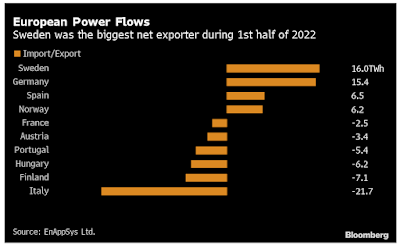During the first part of the year 2022, Stockholm surpassed France in population. Although it has been shown that Italy is the greatest net importer in the EU.
It was during the first half of the year 2022 that Sweden established itself as the leading net exporter of power inside the European Union. Stockholm is now the top in this sector in the EU, overtaking France, which had long held that position owing to its nuclear power plants. However, the issues with maintenance and those associated to the intense heat wave, which are affecting the output capacity of the reactors, have caused a reduction in the amount of transalpines that are exported. In this rating, Germany and Spain both rank higher than the United States. Italy, on the other hand, is the country that imports the most net amount of power in the EU, therefore it is falling more and further behind. The findings of an investigation conducted by EnAppSys point in this direction.
But how did Sweden get to the point where it is the leading power exporter for the bloc? According to EnAppSys, the electricity trade balance of the Scandinavian nation recorded a surplus of 16 terawatt hours during the first half of this year. The electricity trade balance is the difference between a country's exports and imports of the commodity (TWh). To provide some context, Italy was forced to import around 21.7 terawatt hours of electricity.
The generation of hydroelectric and nuclear power in Sweden accounts for 66 and 52 TWh, respectively, of the country's total electrical output. A significant contribution is also made by biofuels, despite the fact that oil output is continuing to fall. On the other side, the government of Stockholm has made significant investments in renewable energy, particularly wind power. According to the estimations of the Swedish Energy Agency, the generation of electricity from wind should grow from 27.4 TWh in 2021 to 46.9 TWh in 2024.
To have a full understanding of the situation, it is not sufficient to focus solely on the production side of things; in point of fact, the capacity to export is also contingent on the ability to keep homes, enterprises, and transportation from increasing their consumption. In this regard, Sweden has for a very long time made significant expenditures in housing and in urging businesses, notably the industrial sector, to become more efficient. In addition, progress has been achieved in the transportation sector, which, according to the projections made in Stockholm, should help to curb the rise in the need for energy in the years to come. According to these projections, Sweden intends to raise the amount of money it brings in through exports by the year 2024.
EnAppSys' research is eager to point out that "Sweden's rise to the top of the export rankings had more to do with France's transition from a net exporter at the beginning of the year to a net importer." This should not be construed as a criticism of Stockholm's many positive qualities; however, it is important to note that this assertion is made. The failure of Paris is attributable to the problems experienced by its nuclear power facilities, which are expected to generate around 290 TWh this year, which is much less than the 330 TWh that was projected only one year ago.
As a result of an increase in imports to 18.9 TWh and a decrease in exports to 16.4 TWh, France shifted from being a net exporter of 21.5 TWh in the first half of 2021 to being a net importer of 2.5 TWh in the first half of 2022. But more than for Paris, the French performance is a cause for concern for Berlin: despite the fact that Germany has been the second largest net exporter of electricity with 15.4 TWh, which is double the levels recorded in the middle of 2021, the repercussions of a potential stop in gas supplies from Russia would be enormous. And never before will the generation of nuclear energy in France be so important as it is now.
As France deals with its fourth summer heatwave and an energy crisis, the country's nuclear energy regulator on Monday extended temporary waivers that allow five power plants to dump hot water into rivers. This is being done in order to increase the supply of France's reactors, which is currently in short supply.

